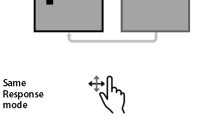Abstract
The study investigated whether the Simon effect, and its facilitation and interference components, shows up in reaction time (RT) or in movement time (MT), depending on the response strategy. Experiment 1 replicated a study by Hietanen and Rämä. Subjects had to press one of two lateralised keys in response to one of two stimuli. The stimuli were presented in the center (neutral condition) or to the left or right side (corresponding or non-corresponding conditions). To press the response key, a reaching movement was necessary, and both RT and MT were recorded. One group of subjects showed an RT facilitation effect and an MT interference effect. Another group of subjects showed both MT facilitation and MT interference effects. It was hypothesized that the two groups used different response strategies. In Exps. 2 and 3, the subjects were explicitly instructed to use the two strategies that were hypothesized for Exp. 1. The results showed that whether facilitation and interference manifest themselves in RT or MT depends on the response strategy adopted by the subjects.
Similar content being viewed by others
Author information
Authors and Affiliations
Additional information
Received: 12 November 1998 / Accepted: 24 April 1999
Rights and permissions
About this article
Cite this article
Rubichi, S., Nicoletti, R., Umiltà, C. et al. Response strategies and the Simon effect. Psychological Research Psychologische Forschung 63, 129–136 (2000). https://doi.org/10.1007/PL00008171
Issue Date:
DOI: https://doi.org/10.1007/PL00008171




